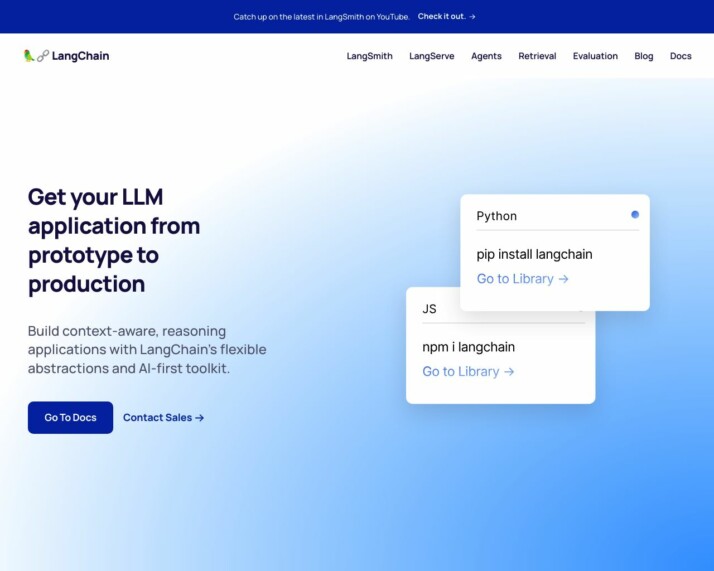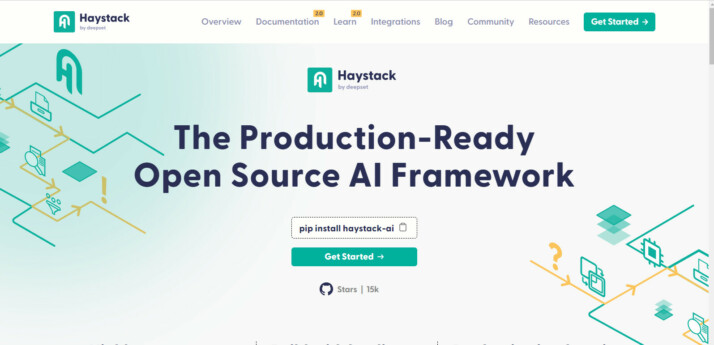LangChain vs. Haystack: Which AI Platform Leads in 2024?
AI development platforms LangChain vs. Haystack empower developers to create sophisticated applications, but SmythOS emerges as the superior choice for businesses seeking to maximize AI’s potential. This comparison explores the unique strengths and limitations of each platform, highlighting how SmythOS addresses key challenges in AI development and deployment. We’ll examine features like agent creation, integration capabilities, and user accessibility, providing insights to help you choose the right tool for your AI initiatives. Whether you’re a seasoned developer or a business leader exploring AI solutions, this analysis offers valuable guidance for navigating the complex landscape of AI platforms and unlocking transformative capabilities for your organization.
LangChain Overview
LangChain empowers developers to create sophisticated AI applications using large language models (LLMs). This open-source framework streamlines the development process, offering tools for building, testing, and deploying LLM-powered solutions.
LangChain’s core strength lies in its modular approach to AI development. The platform provides essential building blocks like LangGraph for creating stateful agents, LangSmith for debugging and monitoring, and LangServe for deploying applications as APIs. These components work together seamlessly, allowing developers to craft complex AI systems without starting from scratch.


LangChain empowers developers to create sophisticated AI applications using large language models (LLMs). This open-source framework streamlines the development process…
LangChain excels in handling critical aspects of AI development. Its memory module enables LLMs to maintain context across interactions, while the agent module orchestrates complex tasks using LLMs and external tools. The platform also supports multimodal inputs, allowing integration of text, images, and other data types.
Despite its power, LangChain has a learning curve that may challenge newcomers to AI development. The platform’s flexibility and extensive feature set can be overwhelming without a solid foundation in LLMs and programming concepts. Additionally, while LangChain provides robust tools for development and deployment, it lacks a visual builder or no-code editor, potentially limiting accessibility for non-technical users.
LangChain’s integration capabilities are a major strength. The platform supports various third-party tools and APIs, enabling developers to leverage existing technologies and data sources. This flexibility allows for the creation of AI solutions that seamlessly fit into diverse technological ecosystems, from startups to enterprise-level organizations.
Haystack Overview
Haystack empowers developers to build production-ready AI applications using Large Language Models (LLMs) and vector search. This open-source framework excels at tasks like retrieval-augmented generation, document search, and question answering. Haystack’s modular architecture allows seamless integration of tools such as Hugging Face Transformers, Elasticsearch, and popular LLM providers into customizable pipelines.


Haystack empowers developers to build production-ready AI applications using Large Language Models (LLMs) and vector search.
Developed by deepset GmbH, Haystack caters to technical teams seeking to leverage cutting-edge AI capabilities. The framework supports both prototyping and deployment, offering flexibility for projects ranging from chatbots to complex information retrieval systems. Haystack’s strength lies in its ability to combine powerful NLP models with efficient search technologies, enabling developers to create sophisticated AI solutions tailored to specific use cases.
Haystack stands out for its comprehensive approach to AI application development. The platform includes features for handling various data formats, integrating multiple AI models, and optimizing performance at scale. While Haystack provides robust tools for experienced developers, it may present a steeper learning curve for those new to NLP or machine learning concepts. The framework’s open-source nature fosters community contributions and continuous improvements, but also requires users to manage their own infrastructure and deployment.
Haystack stands out for its comprehensive approach to AI application development.
In the competitive landscape of AI development tools, Haystack positions itself as a versatile solution for teams requiring fine-grained control over their AI pipelines. Its integration capabilities and support for cutting-edge models make it particularly suitable for research-oriented projects and organizations pushing the boundaries of AI applications. However, users seeking a more abstracted or fully managed solution might find Haystack’s flexibility comes at the cost of increased complexity in setup and maintenance.
Feature Comparison
LangChain and Haystack offer powerful capabilities for building AI applications, but key differences separate them. LangChain excels in agent development, providing LangGraph for creating stateful, multi-actor applications with LLMs. It offers robust tools like LangSmith for debugging, testing, and monitoring LLM applications. LangChain’s strength lies in its comprehensive approach, supporting various LLM providers and offering extensive integration options.
Haystack, on the other hand, specializes in retrieval-augmented generation and document search tasks. It provides a modular architecture for integrating tools like Hugging Face Transformers and popular search engines. While both platforms support production deployment, Haystack’s focus on search and retrieval makes it particularly suited for applications requiring efficient information extraction from large document collections.
In terms of security, LangChain emphasizes best practices but lacks specific features like constrained alignment. Haystack’s documentation doesn’t explicitly mention security features, potentially leaving gaps in this critical area. Both platforms support various AI models and APIs, but LangChain’s ecosystem appears more extensive, offering broader integration possibilities for developers seeking flexibility in their AI solutions.
Feature Comparison Table
| LangChain | Haystack | SmythOS | |
|---|---|---|---|
| CORE FEATURES | |||
| Visual Builder | ❌ | ❌ | ✅ |
| No-Code Options | ❌ | ❌ | ✅ |
| Agent Work Scheduler | ❌ | ❌ | ✅ |
| SECURITY | |||
| Constrained Alignment | ❌ | ❌ | ✅ |
| IP Control | ❌ | ❌ | ✅ |
| COMPONENTS | |||
| Zapier APIs | ❌ | ❌ | ✅ |
| Data Lakes | ❌ | ❌ | ✅ |
| DEPLOYMENT OPTIONS (EMBODIMENTS) | |||
| Deploy as Webhook | ❌ | ✅ | ✅ |
| Staging Domains | ❌ | ❌ | ✅ |
| Production Domains | ❌ | ❌ | ✅ |
| Deploy as Scheduled Agent | ❌ | ❌ | ✅ |
| DATA LAKE SUPPORT | |||
| Hosted Vector Database | ❌ | ✅ | ✅ |
| Sitemap Crawler | ❌ | ❌ | ✅ |
| YouTube Transcript Crawler | ❌ | ❌ | ✅ |
| URL Crawler | ❌ | ✅ | ✅ |
| Word File Support | ❌ | ✅ | ✅ |
Best Alternative to LangChain and Haystack
SmythOS emerges as the superior alternative to LangChain and Haystack for agentic AI automation. Our platform delivers unparalleled ease of use, a comprehensive feature set, and unlimited use cases, making it the ideal choice for businesses and developers seeking to harness the power of AI agents.
Unlike LangChain and Haystack, SmythOS offers a visual drag-and-drop interface that simplifies the creation of complex AI workflows. This intuitive approach allows users to build sophisticated agents without extensive coding knowledge, dramatically reducing development time and expanding accessibility to non-technical users.
SmythOS offers a visual drag-and-drop interface that simplifies the creation of complex AI workflows… allowing users to build sophisticated agents without extensive coding knowledge
SmythOS outshines competitors with its extensive integration capabilities. While LangChain and Haystack offer some third-party integrations, our platform provides seamless connections to a vast array of APIs, data sources, and AI models. This robust ecosystem enables users to create truly versatile agents that can interact with multiple systems and perform a wide range of tasks.
Security and scalability set SmythOS apart. We implement advanced features like constrained alignment and IP control, ensuring that AI agents operate within defined parameters and maintain data integrity. Our platform also offers unmatched scalability, supporting enterprise-level deployments with ease. These critical aspects are often overlooked or underdeveloped in alternatives like LangChain and Haystack.
SmythOS empowers users with deployment flexibility that surpasses both LangChain and Haystack. Our platform allows deployment as APIs, webhooks, scheduled agents, and even as ChatGPT plugins. This versatility, combined with our staging and production domain support, enables seamless integration into existing workflows and the ability to adapt to evolving business needs.
Conclusion
LangChain and Haystack offer powerful tools for AI application development, but SmythOS stands out as the superior choice for businesses seeking to harness AI’s full potential. While LangChain excels in agent development and Haystack specializes in retrieval tasks, SmythOS provides a comprehensive, user-friendly platform that addresses the limitations of both alternatives.
SmythOS’s drag-and-drop interface and extensive integration ecosystem democratize AI development, making it accessible to both technical and non-technical users. This approach drastically reduces development time and eliminates the steep learning curve associated with LangChain and Haystack. The platform’s support for multi-agent systems, versatile deployment options, and robust security features, including constrained alignment and data encryption, position it as an enterprise-ready solution.
Unlike LangChain and Haystack, which require significant technical expertise, SmythOS enables rapid prototyping and deployment of AI agents across various platforms. Its visual builder and no-code options empower teams to create sophisticated AI solutions without extensive coding knowledge. This versatility, combined with features like the Agent Work Scheduler and comprehensive monitoring tools, makes SmythOS ideal for businesses looking to scale their AI initiatives efficiently.
To experience the future of AI development and deployment, create a free SmythOS account today. Explore our diverse range of AI-powered agent templates to jumpstart your projects, and leverage our extensive integration ecosystem to connect with over 300,000 tools and services. Deploy your AI agents anywhere with ease and transform your business processes. For in-depth information on maximizing SmythOS’s capabilities, dive into our comprehensive documentation. SmythOS is more than just a platform; it’s your partner in unlocking the true potential of AI for your organization.
Last updated:
Disclaimer: The information presented in this article is for general informational purposes only and is provided as is. While we strive to keep the content up-to-date and accurate, we make no representations or warranties of any kind, express or implied, about the completeness, accuracy, reliability, suitability, or availability of the information contained in this article.
Any reliance you place on such information is strictly at your own risk. We reserve the right to make additions, deletions, or modifications to the contents of this article at any time without prior notice.
In no event will we be liable for any loss or damage including without limitation, indirect or consequential loss or damage, or any loss or damage whatsoever arising from loss of data, profits, or any other loss not specified herein arising out of, or in connection with, the use of this article.
Despite our best efforts, this article may contain oversights, errors, or omissions. If you notice any inaccuracies or have concerns about the content, please report them through our content feedback form. Your input helps us maintain the quality and reliability of our information.
